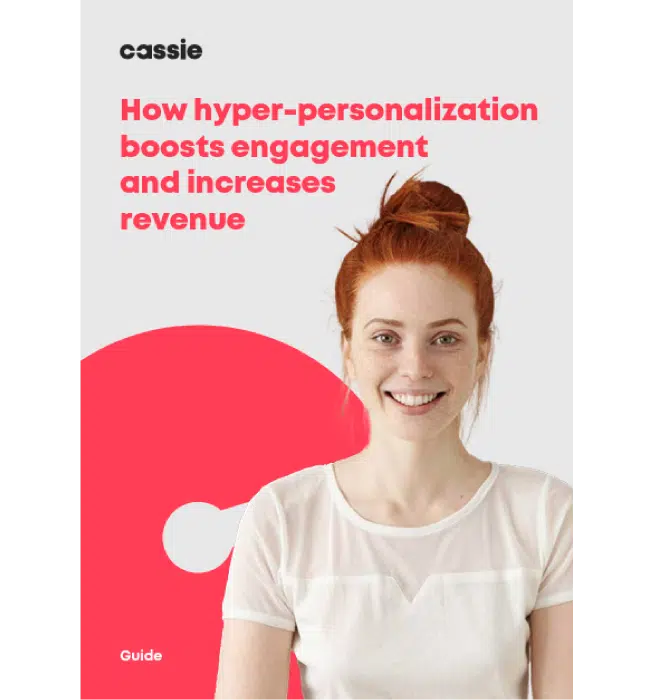The 3 Ps: Personalization, Preferences, and Privacy
Posted: November 8, 2024
People want personalization. We all want to be seen, heard, and gotten, and we prefer to interact with companies that present experiences that make us feel that way. In fact, as a 2024 study reports, 81% of people prefer companies that offer a personalized experience.
There is also evidence to support the idea that today’s expectation of a customized experience goes beyond the opportunity to talk with employees who know shopping behavior and order history. Today’s consumer also wants the opportunity to be presented with the message, offerings, and even the platform or media that are the most meaningful, relevant, and interesting to that consumer. The consumer expects organizations to know and remember them, to the point that they never have to enter data twice, can pick up conversations where they left off, and communicate through their channel of choice at their time of choice.
Though the answer to the question of whether people prefer customization is clear – they do – the answer to the question about the best way to determine how people want a company to interact with them continues to evolve. In the past, organizations have primarily relied on a combination of behavioral analyses, demographics data, and focus group studies to infer an individual’s preferences.
That is, an organization might segment its customer base using demographics data and then infer preferences generally for individuals that it places in that segment. For example, a company might use age to segment its customers into generational categories – Gen X, Baby Boomers, and so on – and determine traits and preferences for each generation based on statistics. For example, a company may determine that Gen X-ers will want to interact through Facebook but not TikTok.
In these cases, though, ‘infer’ and ‘extrapolate’ really mean ‘make an educated guess.’ These techniques shoehorn people into artificial groups and then assume that all people who fall into each category will have the same or similar preferences. This technique certainly has its place. It is efficient and, if done well, can result in personalized experiences that satisfy most individuals.
So, what’s the problem?
The problem is that, while educated guesses may be accurate for some, or even most, of the individuals in an assigned group, they will not account for the enormous variety in people and their preferences. That is, even though each of us falls into a generational category, each of us is also an individual with our own individual likes, dislikes, and personal circumstances.
Additionally, we develop different relationships and expectations with different organizations, so our preferences can be different when interacting with one company versus another. This means that when interacting with people at an individual level, making assumptions about those individual experiences based on segment or category assumptions can lead to lost opportunities and – eventually – lower short-term revenue. At worst, tone deafness in customer experiences can result in negative brand perception and longer-term impacts.
Happily, technological advancements mean that we no longer must guess an individual’s preferences. We can just ask them – directly and specifically – and personalize experiences accordingly. Moreover, since people and needs change over time, we can also not just ask them once, but instead we can leave the lines of communication open so that individuals can change their minds over time.
This is where a consent management platform shows its usefulness far past basic compliance and into personalization. In fact, the three Ps – Personalization, Preferences, and Privacy – work together to create a positive customer experience, woven together through a consent management platform. People care about privacy, and each person has a slightly different take on how they want a given organization to collect and use or share their personal information. Organizations that ask directly about an individual’s privacy preferences obtain the information they need to get it right, rather than guessing and getting it wrong for at least some of the population. That organization can customize whether and how it uses personal data for everyone’s benefit in exactly the way that individual wants – and adjust over time.
A consent management platform is the glue that ties these 3 Ps together. A consent management platform gives us the opportunity to directly ask individuals about their preferences rather than guess what those preferences might be based on group inclusion. It helps craft a pleasing, intuitive, in-context interface through which people can express that they would like to get emails and not text messages, receive communications only once a week, and only on the topics of hamburgers and spiders. Most importantly, a consent management tool helps ensure that an organization follows through on expressed preferences. It pushes privacy requests through the organization to relevant systems, vendors, and business groups.
If we agree with research suggesting that personalization generates revenue by creating improved and more intimate customer experiences, and that people care about privacy and want to be asked for their preferences related to their own personal data, there are a few tips to keep in mind to make sure the 3 Ps work well together.
- Have a strategy – Be clear about what you want to accomplish and identify the data you need to collect, how you need to use it. Also consider what data subjects value, what they want to receive from and experience with your organization, and what options would be helpful and not just burdensome. This clarity about your strategy and data subject expectations and goals will drive answers to other decisions your organization will need to make, like what personalization options should the organization present.
- Gather first-party data – Though it may be tempting to purchase or lease third party data, collecting data directly has multiple benefits. First, with the right collection experience and the back-office practices to fulfil your promises, customers will feel comfortable providing truthful information about themselves, and the organization will have clarity about how it can use that information.
Also, a consumer may have a vastly different relationship with one company than another, so the personal data and preference information a consumer provides directly to an organization – within context – will be the most beneficial combination possible to both the company and the consumer. Third party data providers may have obtained the data in different contexts, or they may have inferred the data points based on other information, which can also create inaccuracies. Collecting information directly, including privacy preferences and consents, and then curating the data subject’s experience based on that collection, will result in the best experience and most flexible data set.
- Identify the single source of truth (and path to get there) – When managing privacy consents and preferences, it is essential to be able to define the logic path for operationalizing expressed consent and preferences into compliant and customer-pleasing, personalized customer experiences. Understanding the data flows, which preferences and consents override others and in which circumstances, and what each consent and preference means in terms of operational outcome demands careful thought, but it is time and energy well spent. A central source of truth location for the decisions is essential in maintaining clear control.
In summary, the three Ps of Personalization, Preferences, and Privacy work together through a consent management platform to result in consumer experiences that hit “right” every time – resulting in higher engagement, revenue, and risk reduction.

How hyper-personalization boosts engagement and increases revenue
Read our How hyper-personalization boosts engagement and increases revenue guide to understand how personalized web experiences can increase conversions.
In this guide, you will learn:
- What the biggest challenges are when it comes to personalization
- The top benefits of personalized email marketing and social media
- Why 50% of Senior Executives are doubling their 2022 investments in personalization enabling platforms
- How preference management powers sustainable engagement and revenue.

